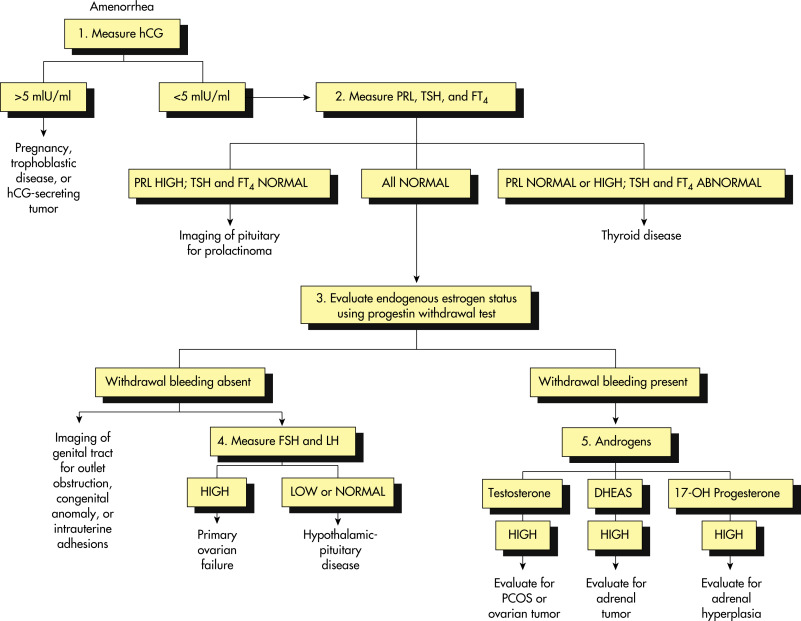AUTHORS: Noushine Sadeghi, MD and Rachel Wright Heinle, MD, FACOG
- Amenorrhea means absence of menstruation. It is classified as either primary or secondary depending on whether the patient has had previous menstrual cycles.
- Workup for primary amenorrhea is indicated for any adolescent age 15 or older who has not reached menarche or who does not reach menarche within 3 yr of thelarche.
- Secondary amenorrhea is the absence of menses for more than 6 mo in a patient who has had previous normal menstrual progesterone withdrawal cycles.
| ||||||||||||||||
|
TABLE E1 Congenital Anatomic Causes of Primary Amenorrhea With Normal Breast Development∗
| Diagnosis | Müllerian Agenesis | Androgen Insensitivity (AI) | Transverse Vaginal Septum | Imperforate Hymen |
|---|---|---|---|---|
| Patients with primary amenorrhea† | 15% | 1% | 3% | 1% |
| Patients with primary amenorrhea and apparent obstruction or absence of vagina† | 75% | 5% | 15% | 5% |
| Chromosomes‡ | 46,XX | 46,XY | 46,XX | 46,XX |
| Gonads | Ovaries | Testes | Ovaries | Ovaries |
| Serum testosterone‡ | Normal female level | Normal male level (high) | Normal female level | Normal female level |
| Vagina | Absent or shallow | Absent or shallow | Obstructed by septum, which may be thick or thin, high or low | Obstructed by thin membrane, which may look blue from hematocolpos |
| Axillary/pubic hair | + | Absent unless AI is incomplete | + | + |
| Cyclic pain | ± | – | + | + |
| Uterus | Absent or rudimentary | – | + | + |
| Mass | – | – | + Can present with acute urinary retention as hematocolpos mass obstructs urethra | + Can present with acute urinary retention |
| Introitus bulges with Valsalva maneuver | – | – | – | + |
| Associated anomalies | Urinary tract and skeletal | Inguinal hernias; gonadal malignancy in adulthood | Major urinary tract abnormalities in 15% | Possibly some increase in urinary tract abnormalities |
| Treatment | Vaginal dilation or surgical neovagina | Gonadectomy after age 16-18 yr Vaginal dilation or surgical neovagina | Surgical approach depends on extent and location of septum; may be extensive; should be done as soon as possible | Excision of hymen as soon as possible; diagnostic needle aspiration contraindicated because of risk of infection |
| Fertility | Advanced reproductive technology required; in vitro fertilization surrogate with uterus to gestate pregnancy | Not fertile | Variable, low septa have a better prognosis than do high septa | Usually fertile |
+, Present; –, absent; ±, may be present or absent.
∗Cervix not visible on pelvic examination. Short vagina; may be absent or obstructed.
† Data from Reindollar RH, Byrd JR, McDonough PG: Delayed sexual development: a study of 252 patients, Am J Obstet Gynecol 140:371, 1981.
‡ Sometimes useful in differentiating Müllerian agenesis from androgen insensitivity.
From Kliegman RM et al: Practical strategies in pediatric diagnosis and therapy, ed 2, Philadelphia, 2004, Elsevier.
- Turner syndrome:
- Usually manifests with primary amenorrhea unless mosaic
- Short stature
- Epicanthic folds
- Low-set ears
- High-arched palate
- Micrognathia
- Sensorineural hearing loss
- Otitis media
- Webbing of the neck
- Pigmented nevi
- Square/shield chest
- Widely spaced nipples
- Absent breast development
- Bicuspid aortic valve
- Coarctation of aorta
- Cubit valgus
- Short fourth metacarpal
- Hyperconvex nails
- Leg edema
- Renal abnormalities
- Autoimmune disorders including thyroiditis
- Diabetes mellitus
- Pure gonadal dysgenesis:
- Müllerian agenesis:
- Transverse vaginal septum and imperforate hymen:
- Androgen insensitivity syndrome:
- Adult-onset congenital adrenal hyperplasia:
- 5-Alpha reductase deficiency:
- PCOS:
- Cushing syndrome (rare disorder, prevalence 1/1,000,000):
- Secondary amenorrhea
- Features of hyperandrogenism
- Abnormal fat distribution (dorsocervical fat pad, spider legs, significant central obesity)
- Abdominal striae due to weakening of skin integument
- Easy bruising
- Hypertension
- Proximal muscle weakness
- Hypothyroidism:
- Primary ovarian insufficiency (previously premature ovarian failure):
- Secondary amenorrhea prior to the age of 40 and elevated gonadotropins (follicle-stimulating hormone [FSH] and luteinizing hormone [LH])
- History of oophorectomy or pelvic radiation or chemotherapy
- Vasomotor symptoms
- Dry, thin vaginal mucosa without rugosity
- Associated autoimmune or karyotypic abnormalities possible
- Hyperprolactinemia:
- Sheehan syndrome:
- Asherman syndrome:
- Functional hypothalamic disorders:
- Kallmann syndrome:

